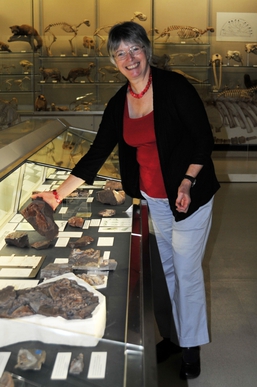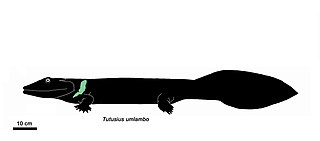
The Devonian is a geologic period and system of the Paleozoic era during the Phanerozoic eon, spanning 60.3 million years from the end of the preceding Silurian period at 419.2 million years ago (Ma), to the beginning of the succeeding Carboniferous period at 358.9 Ma. It is named after Devon, South West England, where rocks from this period were first studied.

A tetrapod is any four-limbed vertebrate animal of the superclass Tetrapoda. Tetrapods include all extant and extinct amphibians and amniotes, with the latter in turn evolving into two major clades, the sauropsids and synapsids. Some tetrapods such as snakes, legless lizards, and caecilians had evolved to become limbless via mutations of the Hox gene, although some do still have a pair of vestigial spurs that are remnants of the hindlimbs.

Sarcopterygii — sometimes considered synonymous with Crossopterygii — is a taxon of the bony fish known as the lobe-finned fish or sarcopterygians, characterised by prominent muscular limb buds (lobes) within the fins, which are supported by articulated appendicular skeletons. This is in contrast to the other clade of bony fish, the Actinopterygii, which have only skin-covered bony spines (lepidotrichia) supporting the fins.

Ichthyostega is an extinct genus of limbed tetrapodomorphs from the Late Devonian of what is now Greenland. It was among the earliest four-limbed vertebrates ever in the fossil record and was one of the first with weight-bearing adaptations for terrestrial locomotion. Ichthyostega possessed lungs and limbs that helped it navigate through shallow water in swamps. Although Ichthyostega is often labelled a 'tetrapod' because of its limbs and fingers, it evolved long before true crown group tetrapods and could more accurately be referred to as a stegocephalian or stem tetrapod. Likewise, while undoubtedly of amphibian build and habit, it is not a true member of the group in the narrow sense, as the first modern amphibians appeared in the Triassic Period. Until finds of other early stegocephalians and closely related fishes in the late 20th century, Ichthyostega stood alone as a transitional fossil between fish and tetrapods, combining fish and tetrapod features. Newer research has shown that it had an unusual anatomy, functioning more akin to a seal than a salamander, as previously assumed.

Jennifer Alice Clack, was an English palaeontologist and evolutionary biologist. She specialised in the early evolution of tetrapods, specifically studying the "fish to tetrapod" transition: the origin, evolutionary development and radiation of early tetrapods and their relatives among the lobe-finned fishes. She is best known for her book Gaining Ground: the Origin and Early Evolution of Tetrapods, published in 2002 and written with the layperson in mind.

Eusthenopteron is a genus of prehistoric sarcopterygian which has attained an iconic status from its close relationships to tetrapods. Early depictions of this animal show it emerging onto land; however, paleontologists now widely agree that it was a strictly aquatic animal. The genus Eusthenopteron is known from several species that lived during the Late Devonian period, about 385 million years ago. Eusthenopteron was first described by J. F. Whiteaves in 1881, as part of a large collection of fishes from Miguasha, Quebec. Some 2,000 Eusthenopteron specimens have been collected from Miguasha, one of which was the object of intensely detailed study and several papers from the 1940s to the 1990s by paleoichthyologist Erik Jarvik.

Panderichthys is a genus of extinct sarcopterygian from the late Devonian period, about 380 Mya. Panderichthys, which was recovered from Frasnian deposits in Latvia, is represented by two species. P. stolbovi is known only from some snout fragments and an incomplete lower jaw. P. rhombolepis is known from several more complete specimens. Although it probably belongs to a sister group of the earliest tetrapods, Panderichthys exhibits a range of features transitional between tristichopterid lobe-fin fishes and early tetrapods. It is named after the German-Baltic paleontologist Christian Heinrich Pander. Possible tetrapod tracks dating back to before the appearance of Panderichthys in the fossil record were reported in 2010, which suggests that Panderichthys is not a direct ancestor of tetrapods, but nonetheless shows the traits that evolved during the fish-tetrapod evolution

Hynerpeton is an extinct genus of early four-limbed vertebrate that lived in the rivers and ponds of Pennsylvania during the Late Devonian period, around 365 to 363 million years ago. The only known species of Hynerpeton is H. bassetti, named after the describer's grandfather, city planner Edward Bassett. Hynerpeton is known for being the first Devonian four-limbed vertebrate discovered in the United States, as well as possibly being one of the first to have lost internal (fish-like) gills.

Tiktaalik is a monospecific genus of extinct sarcopterygian from the Late Devonian Period, about 375 Mya, having many features akin to those of tetrapods. Tiktaalik is estimated to have had a total length of 1.25–2.75 metres (4.1–9.0 ft) based on various specimens.

The Tetrapodomorpha are a clade of vertebrates consisting of tetrapods and their closest sarcopterygian relatives that are more closely related to living tetrapods than to living lungfish. Advanced forms transitional between fish and the early labyrinthodonts, such as Tiktaalik, have been referred to as "fishapods" by their discoverers, being half-fish, half-tetrapods, in appearance and limb morphology. The Tetrapodomorpha contains the crown group tetrapods and several groups of early stem tetrapods, which includes several groups of related lobe-finned fishes, collectively known as the osteolepiforms. The Tetrapodomorpha minus the crown group Tetrapoda are the stem Tetrapoda, a paraphyletic unit encompassing the fish to tetrapod transition.

Ventastega is an extinct genus of stem tetrapod that lived during the Upper Fammenian of the Late Devonian, approximately 372.2 to 358.9 million years ago. Only one species is known that belongs in the genus, Ventastega curonica, which was described in 1996 after fossils were discovered in 1933 and mistakenly associated with a fish called Polyplocodus wenjukovi. ‘Curonica’ in the species name refers to Curonia, the Latin name for Kurzeme, a region in western Latvia. Ventastega curonica was discovered in two localities in Latvia, and was the first stem tetrapod described in Latvia along with being only the 4th Devonian tetrapodomorph known at the time of description. Based on the morphology of both cranial and post-cranial elements discovered, Ventastega is more primitive than other Devonian tetrapodomorphs including Acanthostega and Ichthyostega, and helps further understanding of the fish-tetrapod transition.

Elpistostegalia or Panderichthyida is an order of prehistoric lobe-finned fishes which lived during the Middle Devonian to Late Devonian period. They represent the advanced tetrapodomorph stock, the fishes more closely related to tetrapods than the osteolepiform fishes. The earliest elpistostegalians, combining fishlike and tetrapod-like characters, are sometimes called fishapods, a phrase coined for the advanced elpistostegalian Tiktaalik. Through a strict cladistic view, the order includes the terrestrial tetrapods.

Ichthyostegalia is an order of extinct amphibians, representing the earliest landliving vertebrates. The group is thus an evolutionary grade rather than a clade. While the group are recognized as having feet rather than fins, most, if not all, had internal gills in adulthood and lived primarily as shallow water fish and spent minimal time on land.

Eotetrapodiformes is a clade of tetrapodomorphs including the four-limbed vertebrates and their closest finned relatives, two groups of stem tetrapods called tristichopterids and elpistostegalids.

The evolution of fish began about 530 million years ago during the Cambrian explosion. It was during this time that the early chordates developed the skull and the vertebral column, leading to the first craniates and vertebrates. The first fish lineages belong to the Agnatha, or jawless fish. Early examples include Haikouichthys. During the late Cambrian, eel-like jawless fish called the conodonts, and small mostly armoured fish known as ostracoderms, first appeared. Most jawless fish are now extinct; but the extant lampreys may approximate ancient pre-jawed fish. Lampreys belong to the Cyclostomata, which includes the extant hagfish, and this group may have split early on from other agnathans.

Tutusius is a genus of extinct tetrapod from the Devonian of South Africa, containing a single species, Tutusius umlambo. It was described from the +/- 360 myo Gondwana locality of Waterloo Farm lagerstätte on the south-eastern coast of South Africa, which at the time was located within the Antarctic Circle. Together with the find of Umzantsia amazana from the same locality, this provides the first evidence that Devonian tetrapods were not restricted to the tropics as was formerly believed, and suggests that they may have been global in distribution. Waterloo Farm fossils have been metamorphosed and intensely flattened, with the bone tissue replaced by secondary metamorphic mica that is partially altered to kaolinite and chlorite during uplift. They also provide the first evidence of Devonian tetrapods from the continent of Africa, and only the second and third such taxa from Gondwana.

Umzantsia is an extinct genus of limbed stegocephalians from the Devonian of South Africa. It contains a single species, Umzantsia amazana. The genus is based on ~360 million year old skull and shoulder bones from the Waterloo Farm lagerstätte, a locality on the south-eastern coast of South Africa. In the Devonian, this area of Gondwana was located within the Antarctic Circle. Together with the find of Tutusius umlambo from the same locality, this provides the first evidence that Devonian limbed vertebrates were not restricted to the tropics as was formerly believed, and suggests that they may have been global in distribution. Waterloo Farm fossils have been metamorphosed and intensely flattened, with the bone tissue replaced by secondary metamorphic mica that is partially altered to kaolinite and chlorite during uplift. They also provide the first evidence of Devonian limbed vertebrates from the continent of Africa, and only the second and third such taxa from Gondwana.

The Waterloo Farm lagerstätte is a Famennian lagerstätte in South Africa that constitutes the only known record of a near-polar Devonian coastal ecosystem.
Brittagnathus is an extinct genus of four-limbed vertebrate ("tetrapod") from the Late Devonian of Greenland. It contains a single species, Brittagnathus minutus, which is based on a complete lower jaw recovered from an Acanthostega bonebed in the Britta Dal Formation. It is the fourth named genus of "tetrapod" from the Late Devonian of Greenland, after Ichthyostega, Acanthostega, and Ymeria.
The Zachelmie trackways are a series of Middle Devonian-age trace fossils in Poland, purportedly the oldest evidence of terrestrial vertebrates (tetrapods) in the fossil record. These trackways were discovered in the Wojciechowice Formation, an Eifelian-age carbonate unit exposed in the Zachełmie Quarry of the Świętokrzyskie Mountains (Holy Cross Mountains]. The discovery of these tracks has complicated the study of tetrapod evolution. Morphological studies suggest that four-limbed vertebrates are descended from a specialized type of tetrapodomorph fish, the epistostegalians. This hypothesis was supported further by the discovery and 2006 description of Tiktaalik, a well-preserved epistostegalian from the Frasnian of Nunavut. Crucial to this idea is the assumption that tetrapods originated in the Late Devonian, after elpistostegalians appear in the fossil record near the start of the Frasnian. The Zachelmie trackways, however, appear to demonstrate that tetrapods were present prior to the Late Devonian. The implications of this find has led to several different perspectives on the sequence of events involved in tetrapod evolution.


























